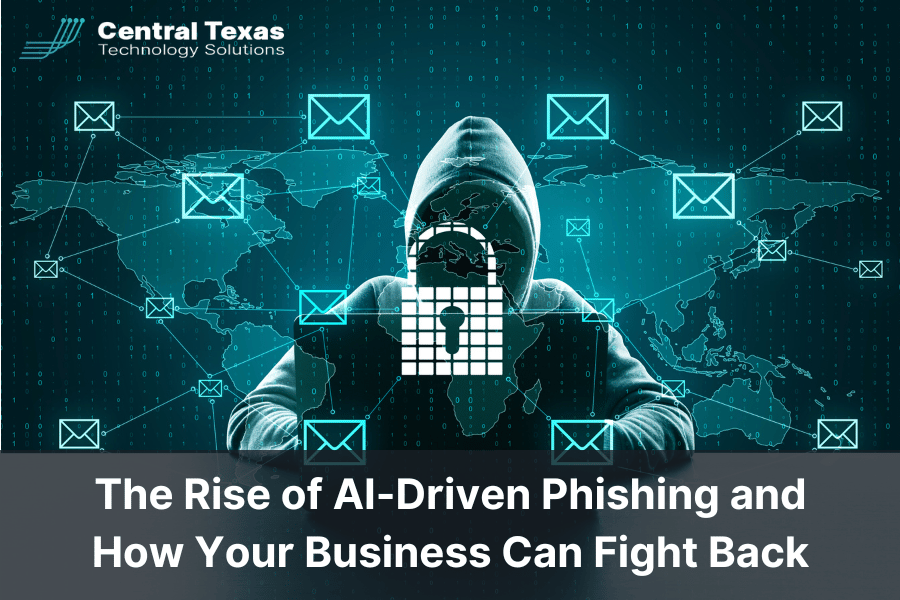
AI-Driven Phishing: A Growing Threat to Businesses
Business leaders are facing a new and rapidly evolving security threat—AI-driven phishing. Hackers now use artificial intelligence to craft highly convincing scams, making traditional cybersecurity measures less effective.
Recent surveys show that more than half of business leaders have encountered phishing attempts in the past two years. What makes these attacks especially dangerous is that cybercriminals leverage AI, machine learning, and natural language processing to impersonate trusted contacts, trick employees, and steal sensitive information.
With the legal, financial, and reputational risks of a security breach potentially devastating a company, businesses must take proactive steps to defend against AI phishing scams before they strike.
Why AI-Driven Phishing Is More Dangerous Than Ever
Traditional phishing attacks often contained noticeable red flags, such as poor grammar, generic greetings, or mismatched email addresses. But AI-powered phishing attacks are far more sophisticated and harder to detect. Here’s why:
- Deepfake Technology – Hackers can generate fake images, videos, and even voices that closely mimic real people, making fraudulent communications seem authentic.
- Hyper-Personalized Attacks – AI can analyze publicly available data (such as LinkedIn profiles and past emails) to craft highly targeted messages that sound like they came from a trusted colleague or vendor.
- Automated Large-Scale Scams – Machine learning enables attackers to send out millions of unique phishing emails, bypassing spam filters and increasing their chances of success.
Without robust AI phishing defenses, businesses are at serious risk of data theft, financial fraud, and regulatory violations that could cripple their operations.
How Businesses Can Defend Against AI-Driven Phishing
Stopping AI-driven phishing attacks requires a multi-layered defense strategy combining employee training, advanced cybersecurity tools, and strict access controls.
1. Employee Education: Your First Line of Defense
Human error is one of the biggest risk factors in phishing attacks. Businesses must invest in ongoing security training to ensure employees can spot and avoid scams. Best practices include:
✔ Recognizing phishing red flags – Look for subtle signs like slightly altered domain names, urgent requests for sensitive data, or unusual language.
✔ Using verification protocols – Always confirm requests for payments or confidential information via a separate channel (such as a phone call) before taking action.
✔ Running phishing simulations – Conduct regular tests to see how employees respond to mock attacks and provide additional training as needed.
2. Deploy Advanced Cybersecurity Technology
AI-powered attacks require AI-powered defenses. Businesses should implement:
🔹 AI-Based Email Security Filters – These tools analyze incoming emails for suspicious patterns, blocking potential phishing attempts before they reach employees.
🔹 Multi-Factor Authentication (MFA) – Require users to verify their identity with two or more authentication methods before accessing sensitive systems.
🔹 Real-Time Threat Detection – Use machine learning-powered security software to identify phishing attempts based on historical attack patterns.
3. Adopt a Zero-Trust Security Model
A zero-trust approach assumes that no user or system should be automatically trusted. Instead, strict access controls and continuous verification help prevent unauthorized access.
Key zero-trust strategies include:
- Least Privilege Access – Ensure employees only have access to the data and systems necessary for their role.
- Continuous Authentication – Require users to revalidate their credentials regularly, even after logging in.
- Behavior-Based Security – Detect and flag suspicious activity that deviates from normal user behavior.
Stay One Step Ahead of AI Phishing Attacks
No business is immune to AI-powered phishing scams, and ignoring the risk is no longer an option. The key to preventing costly cyberattacks is a proactive, multi-layered security strategy that includes:
- Employee training to detect and avoid phishing attempts.
- AI-driven cybersecurity tools that block malicious emails and verify user identities.
- Zero-trust security policies that limit unauthorized access to sensitive systems.
By staying vigilant and investing in the right security measures, businesses can protect their data, finances, and reputation from AI-enhanced cyber threats.
FAQ: Protecting Your Business from AI-Driven Phishing
1. How can AI help stop AI-powered phishing attacks?
AI-based security tools can detect phishing patterns, flag unusual login attempts, and analyze email content in real time, preventing many attacks before they reach employees.
2. What should employees do if they suspect a phishing attempt?
Employees should not click on any links or attachments, verify the sender through an independent source, and report the email to their IT security team immediately.
3. Is multi-factor authentication enough to stop phishing attacks?
While MFA adds an extra layer of security, it should be combined with email filters, employee training, and a zero-trust approach for the best protection.
Contact CTTS today for IT support and managed services in Austin, TX. Let us handle your IT so you can focus on growing your business. Visit CTTSonline.com or call us at (512) 388-5559 to get started!
